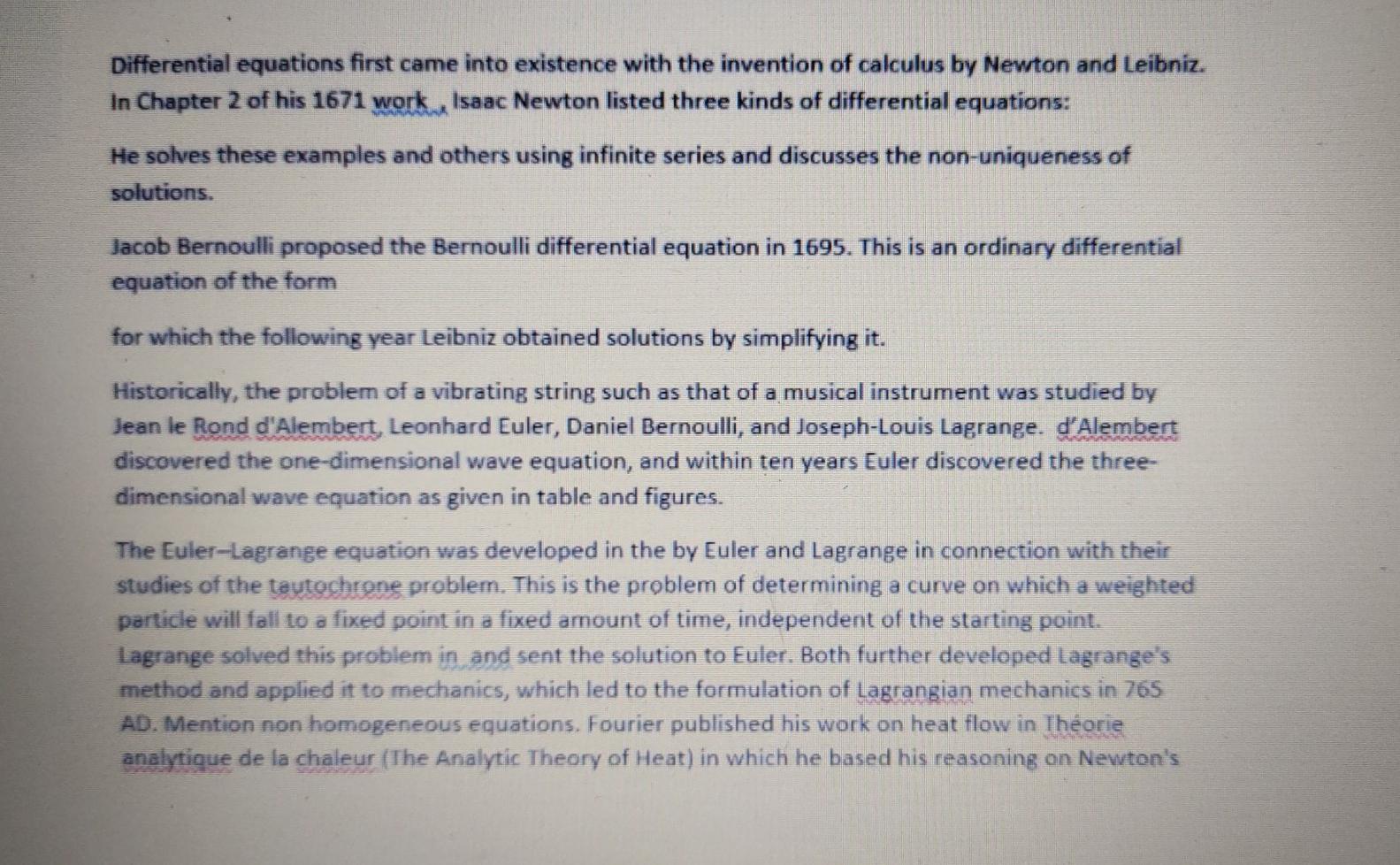Answered step by step
Verified Expert Solution
Question
1 Approved Answer
I will downvote for sure if answered wrong.I need answer as soon as possible. All information is given in the question and If u dont

I will downvote for sure if answered wrong.I need answer as soon as possible. All information is given in the question and If u dont know the complete answer Then dont try to attempt it. I will downvote if you provide wrong answer
Differential equations first came into existence with the invention of calculus by Newton and Leibniz. In Chapter 2 of his 1671 work, Isaac Newton listed three kinds of differential equations: He solves these examples and others using infinite series and discusses the non-uniqueness of solutions. Jacob Bernoulli proposed the Bernoulli differential equation in 1695. This is an ordinary differential equation of the form for which the following year Leibniz obtained solutions by simplifying it. Historically, the problem of a vibrating string such as that of a musical instrument was studied by Jean le Rond d'Alembert, Leonhard Euler, Daniel Bernoulli, and Joseph-Louis Lagrange. d'Alembert discovered the one-dimensional wave equation, and within ten years Euler discovered the three- dimensional wave equation as given in table and figures. The Euler-Lagrange equation was developed in the by Euler and Lagrange in connection with their studies of the teutochrone problem. This is the problem of determining a curve on which a weighted partide will fall to a fixed point in a fixed amount of time, independent of the starting point. Lagrange solved this problem in and sent the solution to Euler. Both further developed Lagrange's method and applied it to mechanics, which led to the formulation of Lagrangian mechanics in 765 AD. Mention non homogeneous equations. Fourier published his work on heat flow in Thorie analytique de la chaleur (The Analytic Theory of Heat) in which he based his reasoning on Newton's Differential equations first came into existence with the invention of calculus by Newton and Leibniz. In Chapter 2 of his 1671 work, Isaac Newton listed three kinds of differential equations: He solves these examples and others using infinite series and discusses the non-uniqueness of solutions. Jacob Bernoulli proposed the Bernoulli differential equation in 1695. This is an ordinary differential equation of the form for which the following year Leibniz obtained solutions by simplifying it. Historically, the problem of a vibrating string such as that of a musical instrument was studied by Jean le Rond d'Alembert, Leonhard Euler, Daniel Bernoulli, and Joseph-Louis Lagrange. d'Alembert discovered the one-dimensional wave equation, and within ten years Euler discovered the three- dimensional wave equation as given in table and figures. The Euler-Lagrange equation was developed in the by Euler and Lagrange in connection with their studies of the teutochrone problem. This is the problem of determining a curve on which a weighted partide will fall to a fixed point in a fixed amount of time, independent of the starting point. Lagrange solved this problem in and sent the solution to Euler. Both further developed Lagrange's method and applied it to mechanics, which led to the formulation of Lagrangian mechanics in 765 AD. Mention non homogeneous equations. Fourier published his work on heat flow in Thorie analytique de la chaleur (The Analytic Theory of Heat) in which he based his reasoning on Newton'sStep by Step Solution
There are 3 Steps involved in it
Step: 1

Get Instant Access to Expert-Tailored Solutions
See step-by-step solutions with expert insights and AI powered tools for academic success
Step: 2

Step: 3

Ace Your Homework with AI
Get the answers you need in no time with our AI-driven, step-by-step assistance
Get Started


